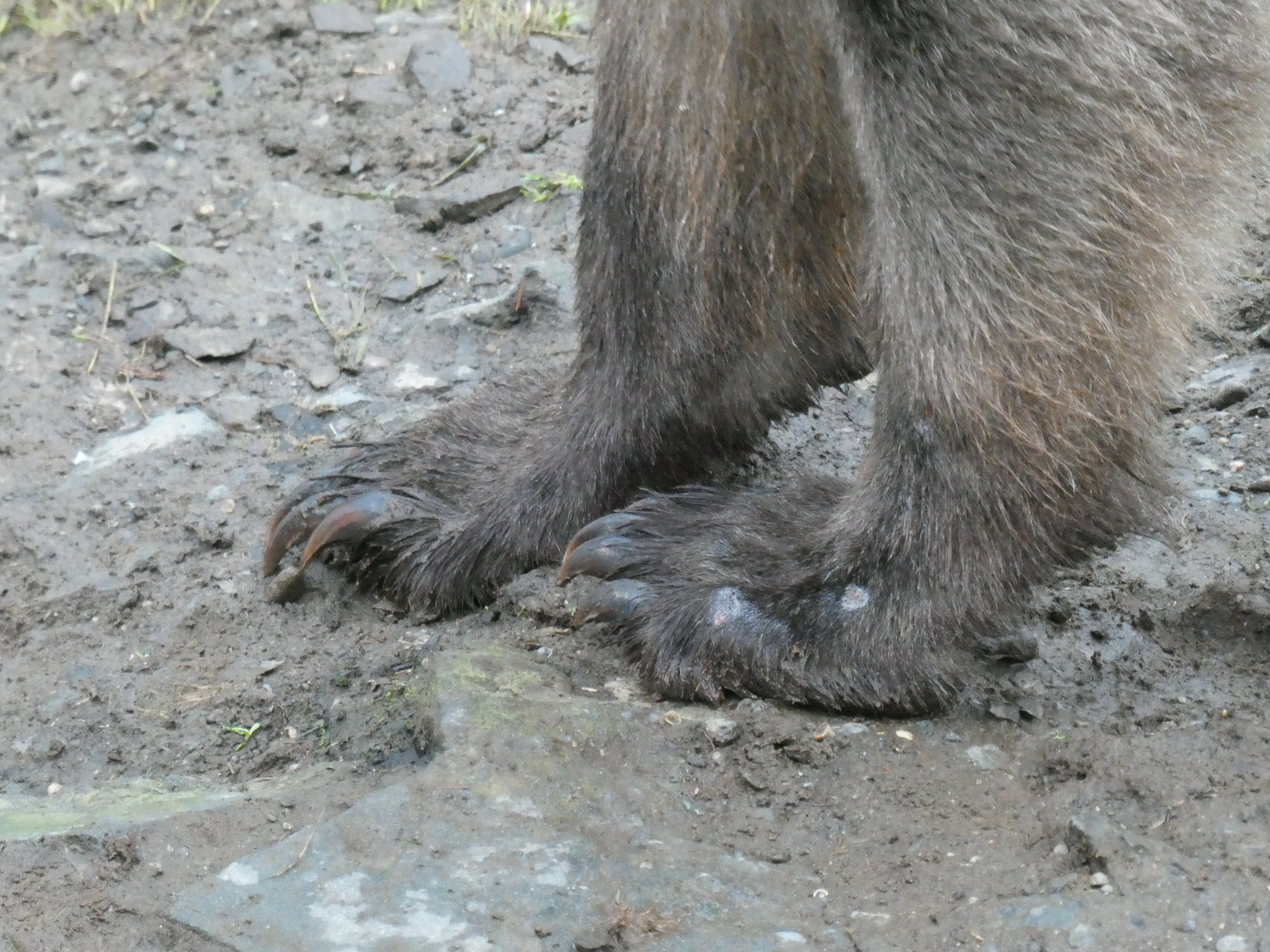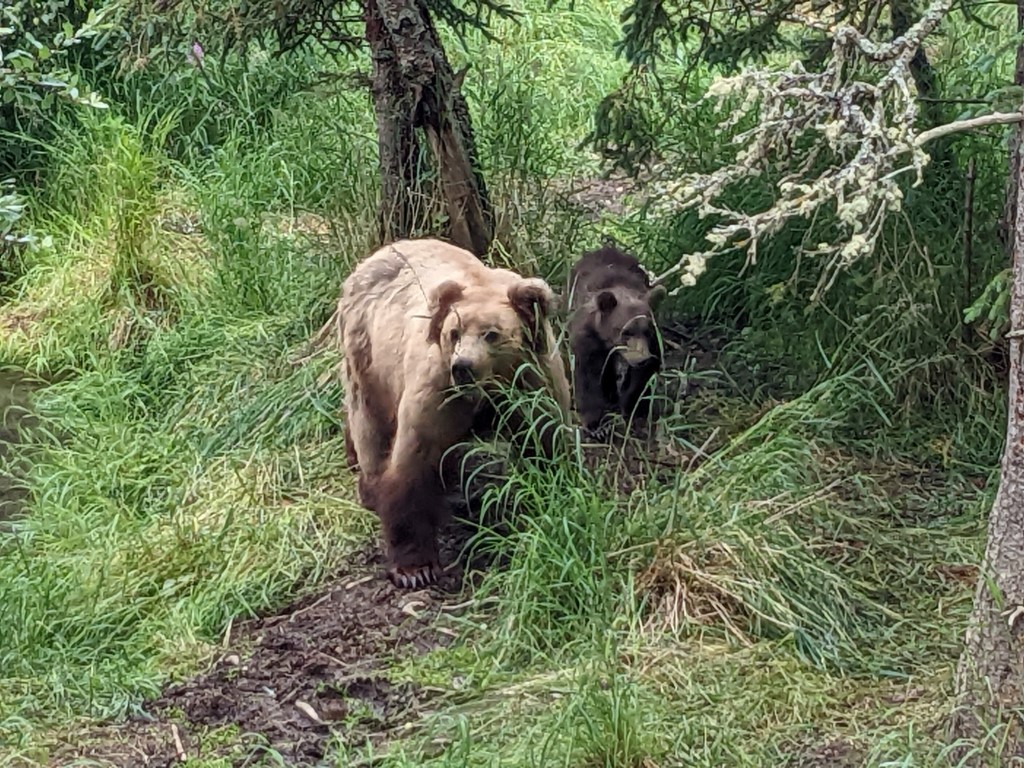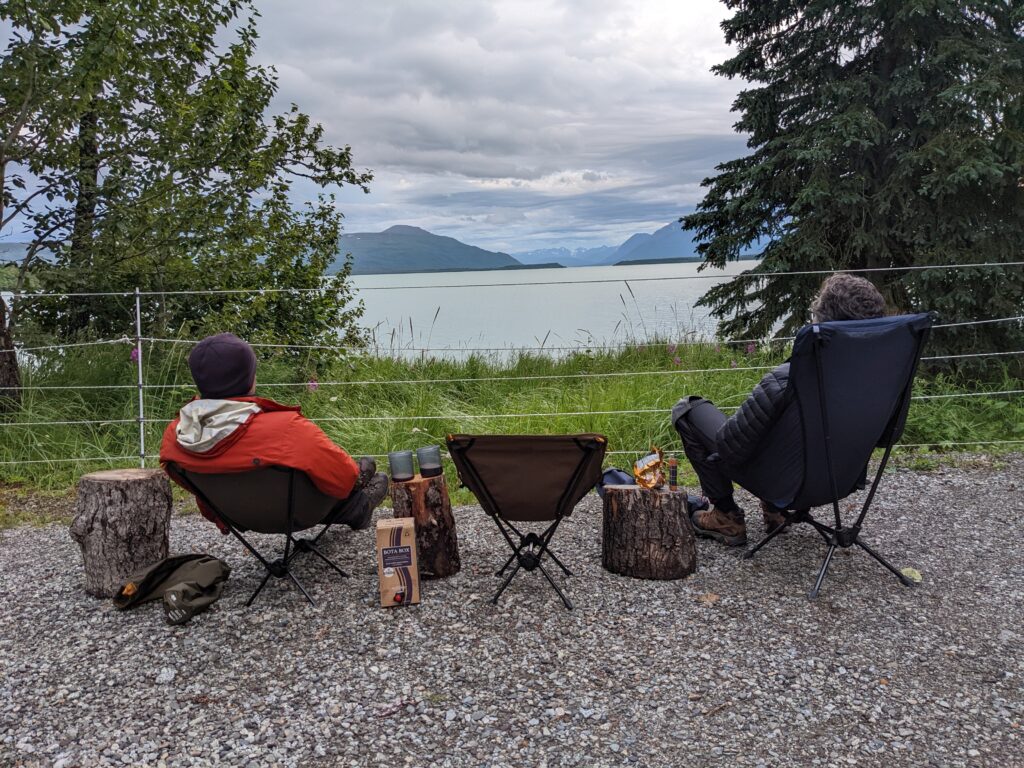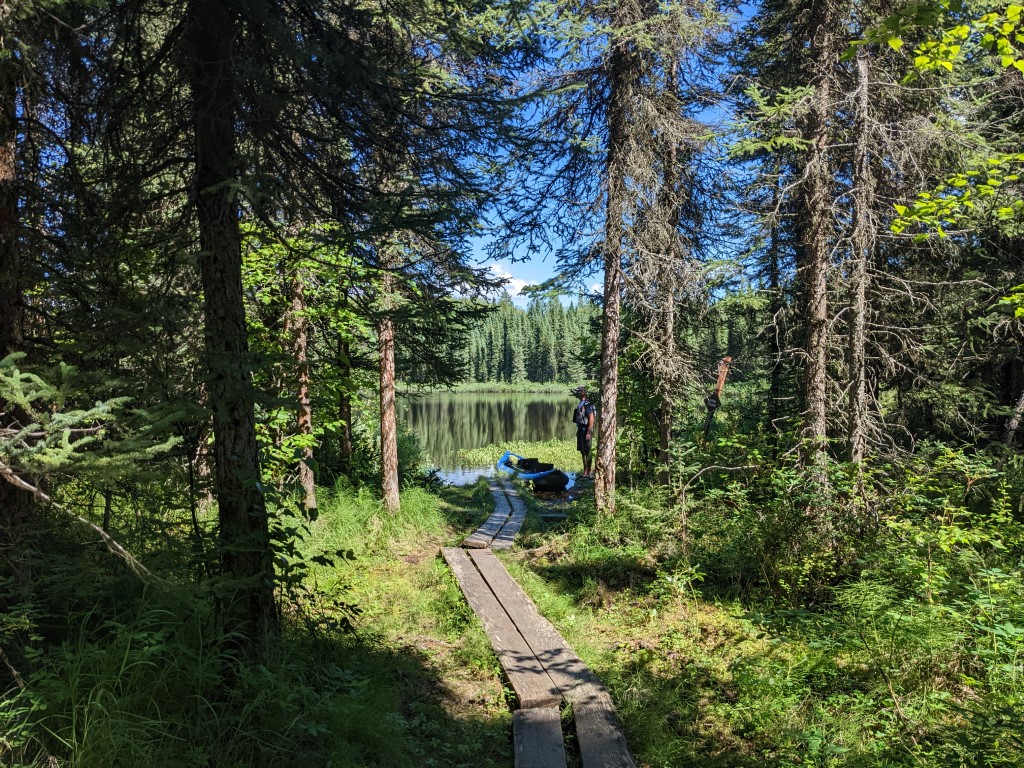
We started planning a trip to Katmai National Park way back in January when we were sitting in the Baja with Ivan, Sandie & Karsten. Because of continued worldwide covid concerns, the 5 of us decided that this was going to be the year to go to Alaska. We didn’t get a reservation in January when the park service released half of the campsites for Brooks Campround at Katmai even though all 5 of us were sitting at our computers trying when the clock ticked 8am. Again, Jon & I tried in March while passing through Vegas when the 2nd half of the campsites opened up and we actually got some for perfect timing-mid July when the bears would be there in full force catching salmon. Then as it got closer, we got nervous. Would the bears be there? They arrived late last year because the salmon were late. Would they be late again? We had flights, water taxis, the campspot, everything paid for and non-refundable. Then the forecast was for rain and more rain. Oh well, we would get wet. I read later that the sun only shines 20% of the time in summer there anyway. At least we had a campsite and things would be much easier than backpacking while there which is what we were going to do if we couldn’t get a spot in the campground. We really wanted to experience that scene and bears everywhere. For this trip, it would be Ivan, Jon & I and Sandie & Karsten were heading off to see bears in Wrangell. We all left about the same time, going our separate paths.
First was a flight to King Salmon from Anchorage, then a shuttle bus from the airport to the shore of Naknek Lake, the largest lake in Katmai at 40 miles long. While waiting in the shuttle for the water taxi to arrive, the shuttle driver said oh you’re camping? The camping is INTENSE! Already nervous we were all thinking intense? Oh no what does that mean? It was all an unknown at that point. Then he admitted to his joke and said IN TENTS! Oh phew. He managed to catch us twice more and we were glad to get out of his shuttle to reduce our stress level. Then a 45 minute ferry ride across the lake to get to Brooks Camp. It’s where it all happens. You can only ferry or float plane to it. The bears occupy Brooks Falls and surrounding area for July- Sept and the whole area is within Katmai National Park. Like most of Alaska’s national parks, relatively inaccessible. But there at Brooks Camp there is a lodge that serves up buffet meals, hot showers, a hot fireplace for drying out and a few other amenities.
Even as we approached the beach, we could see a mom with her 4 cubs. The water taxi driver said we’d be deleting any pictures we took & not to worry, we would be seeing PLENTY of bears. He whisked us off to the visitor center with a huff and after a bear safety class, we carried our packs to the campground. It was really cute, set inside an electric fence to discourage bears, full of bright flowers, green trees, a nice campspot, a gear storage and food storage area and cooking shelters with tables since all cooking had to be done in those shelters. We set up camp, strung up a separate tarp in preparation for copious amounts of rain and set off to the bear platforms.
It is about a 1.4 mile walk from the campground to the Falls platform, and there are other boardwalks, trails and platforms along the way. You can see bears at various points along the way- on the beach, on the trails, sleeping in the woods, fishing in the shallower shoreside areas, fishing way out into the river and in the riffles just down from the falls. Bears on shore can be seen sleeping, cubs are nursing, some are feuding, usually over salmon and some are just pacing around. You just give them the right of way except for right in front of the lodge where there are park rangers constantly cordoning off areas where bears are hanging out or resting so that they can have their space or sometimes just chasing them away by banging on metal pans tied to their belts. It reminds me of some cartoon where it was a full time job for the sheep protecting the flock to ward off the coyote and they just punched time cards for the work day.
We were amazed at the sheer number of bears, their individual looks (reminds me of people), their size, disposition (they didn’t seem to give a care about us but they sure cared about each other) and the way they communicate and relate to each other. At most there were 32 bears in sight at the falls but there were many more in other areas, just behind us or in the woods. The hierarchy means the big boys are usaully at the top of the falls or just under it where the fishing is best if you’re good at fishing and the rest of the females, adolescent males and cubs, filled in the other areas, always backing away when a dominant bear neared. I noticed they often pick up a front paw when submitting. Old bears had their corner of the falls and bears that didn’t like people would be further away or in other areas along the boardwalk. Then there was horny bear who was chasing all the girls even though mating season is pretty much over.

Cubs were born in Jan/Feb and were still quite small. It was fun to watch them hopping around following their protective moms. We felt bad that they weren’t getting much salmon but a ranger told me most of them were still nursing so scraps were good enough for now. There is always a threat that males will kill the cubs so moms keep them close but I read that females have been known to kill cubs too. Speaking of things I read, here are a few tidbits. A bear’s sense of smell is many times better than a dog. The prominent hump of a brown bear is basically a ball of muscle that helps give power to their legs. Their claws are long and strong and I enjoyed studying their funny looking feet and the way they put them down when walking. Brown bears are just the larger version of grizzly bears, they grow larger in this part of Alaska mainly due to the rich salmon that they eat.
Because they are true hibernators, they need to eat a year’s worth of food in just 6 months. While hibernating, their heart slows to 9 beats per minute with about 1 breath/minute, their kidneys all but shut down and all metabolic needs are met by breaking down fat stores. Metabolites are recycled into proteins that support muscle and bone such that when a bear energes from hibernation, it has lost fat, not muscle or bone density. They can burn as many as 4000 calories per day to support themselves but they won’t eat, drink, defectate or urinate for all that time. Amazing! So at Brooks camp anyway, where park staff have been studying these bears year after year, they know that on average, bears there will consume about 90 salmon per day as long as the salmon are there, gain 2 pounds of fat per day and yo-yo dieting is beneficial for bears to survive the winter, unlike us mere humans who succumb to heart disease from it. When they first emerge in Spring they start eating grass and sedge, then they hunt moose calves and then they move in to salmon as soon as they can. The park service produces a free ebook download available off their website that summarizes this research and the lives of individual bears of Brooks Camp. It’s called the Bears of Brooks River.




Salmon in the river 




This bear loved to fish out on his own like he was at sea!
After that first evening of bear watching, the three of us walked back to the campground elated. We made dinner in the cooking shelter and met other campers. One guy had come in by pack raft, having pack rafted through a good portion of the park. We are hot on the idea of packrafts having seen so many people using them. It would fit our style and enable us to hike to a float and hike back which is something we’d enjoy. It was great to hang out and learn what it’s like. The rain had held off but then it settled in for the night. I laid in my sleeping bag like it was Christmas Eve, anxious for it to be morning so that we could go see the bears again.
And so it went for the following 3 days. We would go bear watching at least twice a day, enjoying the walk over and back. Then we would check out a short trail, watch bears on the beach, have a coffee & snack and put up our feet, take showers, sit by the fireplace in the lodge and rummage around in our stuff looking for whatever we had misplaced. Everything takes longer when you’re living out of a tent and backpack. It rained off & on during the day and often hard at night. Our tarp helped but it wasn’t the waterproof that was advertised so we returned it when we got back from the trip. We had stuffed a box of wine into our luggage so we enjoyed our happy hours and “cooking” our meals together with whomever we met at the picnic tables. One afternoon Jon & I hiked up to the lookout at Dumpling Mountain and the sun actually came out which was something like a religious experience. We came down to the campground to see Ivan sitting by the lake reading a book like he was on vacation. It looked so perfect. Then it started to pour. I think it was that night that we went to see the bears in the rain like it was medicine and we got pretty drenched. His camera fogged up, we got cold, the wind picked up, the tarp was rubbing against Ivan’s tent making it wick water and it seemed like the rain would never stop. I thought about the bears, out there in all of it, in and out of the cold river water, their fur never drying out, walking their homemade now muddy paths to and from the river, time & time again driven to feed themselves. It’s all relative. And I thought about why is it that watching them makes us so happy?
So the only ones that have it harder is the sockeye salmon that use this river to reproduce. They were born right there, swam down to the sea, avoided being eaten there, reached maturity and began their voyage from sea to birthplace again. Past commercial fishing nets. Past the locals with their boats, nets, waterwheels, hooks. The constant current. Then they have practically only one fall left to jump and what is waiting at the top of the falls??? A big mouth full of teeth!! If caught, the bears mainly eat the head and then pull off the skin, maybe a bite or two and then they discard the fish to get another. Then another bear further downstream will likely pick up the fish and have some, then last the birds get the rest. If they make it past the teeth to Brooks Lake above it, they will turn pink & green, lay their eggs, and guard them till they die. It really is a web of life.
Brooks Camp can get busy with day trippers between 9-4. It really wasn’t bad. I’m so glad we weren’t discouraged about coming fearing crowds because it wasn’t like that. Even so, outside of those hours, it’s just the campers and lodge guests. We loved that solitude and would stay on the platform till 10p when there seemed to be more bears than ever. That aspect of being able to see them for long periods, time and time again was what made this so special to us. Rarely do you get the chance with any wildlife that you see to stay as long as you want. There is always something that makes it end. A passing car, the animal gets scared or walks behind a tree, you run out of air underwater, the tour is over, whatever. But this time, for once, we didn’t have to leave. And when we did, we came back later. We saw the same souls many times and got to know where they liked to hang out and we could find them there again and again.
We had a day tour booked for the Valley of Ten Thousand Smokes led by a park ranger but it got cancelled because the bus broke down. We were so bummed. It was going to be our intellectual stimulation! In 1912, the Novarupta volcano exploded not far from Brooks camp and for 60 hours, ash & pumice fell from the sky. It was 30 times more magma than the Mt St Helens explosion of 1980. One of the 5 largest eruptions worldwide. It left this otherworldly, supposedly amazing area that was once full of steaming fumaroles but even now is quite something to see. Well, we couldn’t see it. The pumice still floats down the lake and lands at the beach so we could see that. So we took a 5 mile walk down the first part of the 22 mile road that we would’ve been riding down in the park bus had it not broken, following a waddling bear for the first couple of miles before turning around and walking 5 miles back. You can’t have it all.

I think none of us are going to ever see a bear alongside the road or on a trail and feel the same rush that we felt at Katmai.
I felt kind of blue dismantling our camp and saying goodbye but I also felt like we DID Brooks Camp. I noticed the bus was fixed and the tour was back on schedule for our departure day which made me growl. We did the trip in reverse with an early morning water taxi, shuttle bus (where the driver got us again by saying “Hey there’s a wolf” and indeed, there was the sign for Wolf Rd. Bugger!), then a couple of hours in the town of King Salmon waiting for the flight. The town is nothing much but it’s proximal to the famous Bristol Bay, a huge salmon fishing area with canneries and infrastructure to support a swell of 20,000 workers during the summer. Our plane was full of them on the way back, young guys who had come to work a partial summer in the fishing world. Hard work.
We got back to Anchorage and hit the laundromat so we could get everything clean and dry and put away. We don’t have room in our truck for much stuff to not be in its place. Then we get a message from friends Pato & Cathy, who are in Anchorage too. We met these guys while showing our truck at the Overland Expo in Arlington, VA in 2019. We were in the midst of selling Evergreen. They sat in our unfinished DIY build truck and we talked for an hour. We stayed in touch and within a couple of months we found out that they had a similar but fancier truck on order!! It’s great to know that we helped inspire them to have a similar truck as ours and it was even more fun to finally meet up after all this time. We realized that we all have the same expresso machine. Funny. We went out to dinner that night to catch up and we hope there are plenty more catch-ups in the future.
Just before we left for Katmai, I lost my Aunt Mary. Then upon returning, we found out we’d lost a dear friend Ali, way too early. Life is fragile. We want to really live it. In this way, we feel like we’re doing it.







Sandie & Karsten 




After re-stocking, we headed to Hatcher Pass, a famously beautiful area outside of Anchorage because it is drive-up alpine scenery. We stayed 2 nights and the 5 of us did some hikes together. We even got to sit outside in the sun one evening for happy hour. It felt novel.
Then Jon & I headed off a few more miles down the road to do the Lynx Lakes Canoe Route in the Nancy Lakes Recreation Area. A necklace of 14 small lakes with portage trails between them and signs directing you to each pull-out makes a nice way to get a good upper and lower body work-out! We saw loons and ospreys and plenty of quiet. The scenery was pretty and on the perfect weather we had for it, it felt like summer again. We decided to affectionately rename the trail the Portage Trail because it felt like there was as much portage as kayaking but we enjoyed the trail and it was unique in things we’ve done. I love how Alaska has a never ending amount of public space and wildnerness to explore. It is unmatched in my experience.
The summer is marching on, the days are getting shorter although we still have to pull the shades at night. We’re heading out for a 3 day backpack trip tomorrow at K’esugi Ridge. It spends a lot of time on a ridge that looks over to Mt Denali. Hopefully we’ll get some views. Then we’ll be headed to Denali NP and on northward towards Fairbanks and probably, the Arctic. Towards the light. With good company.














































